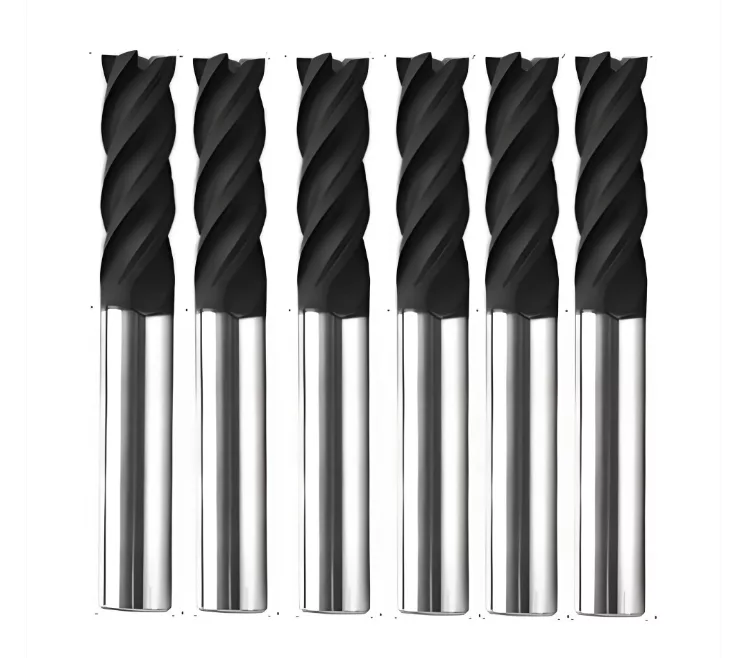Aluminum alloy is widely used in automotive, aerospace, and 3C manufacturing due to its light weight, high strength, and good formability. However, its inherent softness, low melting point, and strong adhesion pose significant challenges to milling operations—common issues include built-up edge (BUE), rapid tool wear, and poor surface finish. Diamond coatings have emerged as a game-changing solution, addressing these pain points through their exceptional material properties and compatibility with aluminum alloy machining.

Core Advantages of Diamond Coatings for Aluminum Alloy Milling
1. Superior Hardness and Wear Resistance
Diamond boasts an ultra-high hardness of 80–100 GPa, 5–6 times that of conventional cemented carbide (1500–2000 HV) . This "hard cutting soft" characteristic ensures the cutting edge remains sharp even during high-volume machining. For example, when processing high-silicon aluminum alloy (a common material in new energy vehicle motor housings), diamond-coated end mills achieve a tool life 8–12 times longer than uncoated carbide tools . The wear resistance is further enhanced by the SP3 diamond structure (accounting for over 95% of the coating), as specified in the Chinese national standard JB/T 11449-2013 .
2. Low Friction and Anti-Adhesion Performance
Diamond coatings exhibit an extremely low friction coefficient of 0.04–0.1 against aluminum alloys, far lower than that of carbide (0.6+) or Ti-based coatings (0.6+) . This minimizes contact between the tool and workpiece, effectively inhibiting aluminum chip adhesion and BUE formation. Hydrogen-free diamond-like coatings, a variant of diamond coatings, have been proven to improve chip evacuation and maintain cutting edge sharpness, reducing burr formation in slot milling and hole drilling .
3. Excellent Thermal Conductivity
With a thermal conductivity of 1000–2000 W/(m·K)—more than 10 times that of cemented carbide (80–150 W/(m·K)) —diamond coatings rapidly dissipate cutting heat. This prevents tool edge softening and workpiece thermal deformation, critical for maintaining dimensional accuracy. During dry machining of 6061-T6 aluminum with micro end mills, diamond coatings enable high-speed operations (40,000 rpm) without overheating .
4. Chemical Inertness and Stability
Diamond is chemically inert to aluminum alloys, avoiding unwanted reactions even at elevated cutting temperatures . Unlike PCD tools containing cobalt binders (which accelerate diamond graphitization), CVD diamond coatings maintain structural stability, ensuring consistent performance throughout the tool's lifespan . This stability also contributes to superior surface finish, with Ra values as low as 0.4 μm—four times better than carbide tools .
Technical Standards and Application Validation
The performance of diamond-coated tools is regulated by industry standards such as JB/T 11449-2013, which mandates key requirements: coating thickness ≥4 μm (8–10 μm recommended for aluminum processing), hardness ≥7000 HV₀.₀₂₅, and substrate cobalt content ≤10% for optimal adhesion . CVD (Chemical Vapor Deposition) technology, widely adopted for coating fabrication, enables uniform coverage on complex tool geometries (e.g., micro end mills) with grain sizes as small as 2 μm .
In practical applications, diamond-coated micro end mills (300 μm diameter) have demonstrated exceptional results in dry machining 6061-T6 aluminum: reduced cutting forces, minimal tool breakage, and predictable surface finish . For 6063 aluminum alloy and 5052 aluminum substrates, these coatings extend drill life by 3 times and maintain dimensional accuracy even after 10 meters of milling .
Diamond coatings address the core challenges of aluminum alloy milling by combining ultra-high hardness, low friction, excellent thermal conductivity, and chemical stability. They deliver longer tool life, higher processing efficiency, and superior surface quality—making them the preferred choice for precision manufacturing in automotive, aerospace, and consumer electronics industries. As coating technology advances (e.g., boron-doped and gradient diamond coatings), their application scope will continue to expand, driving innovation in aluminum alloy processing.


